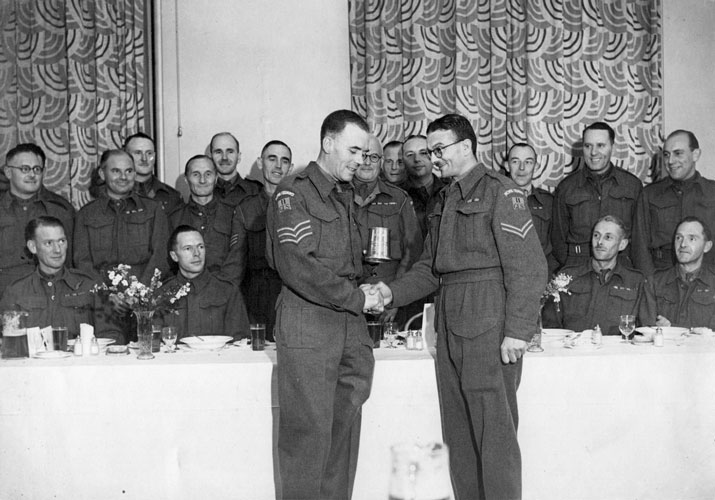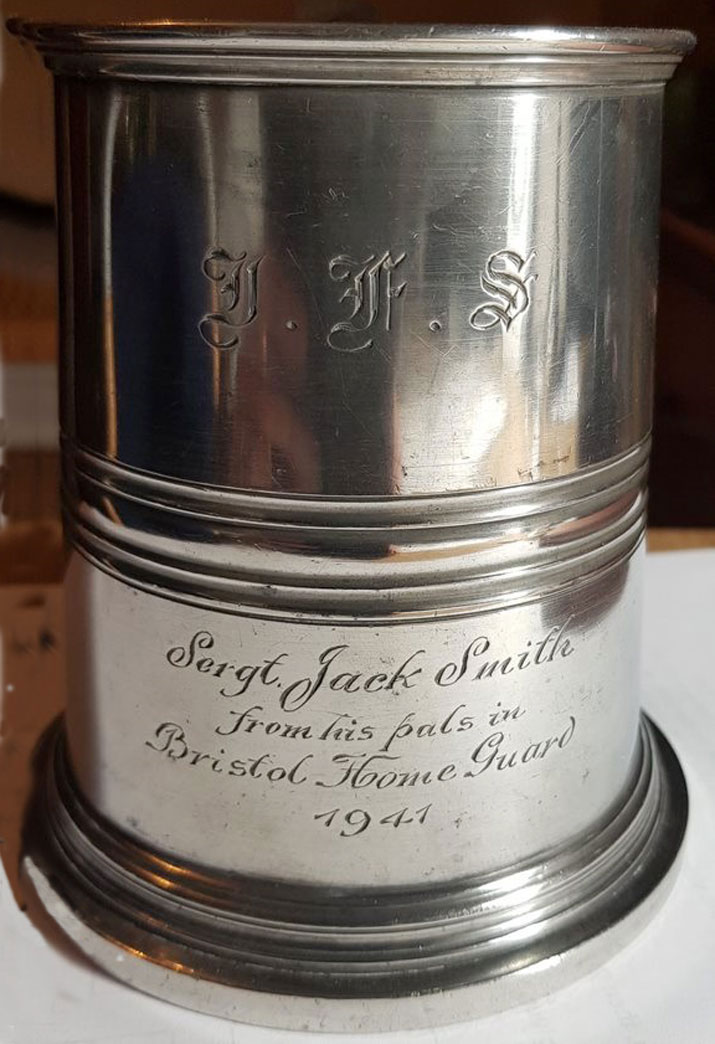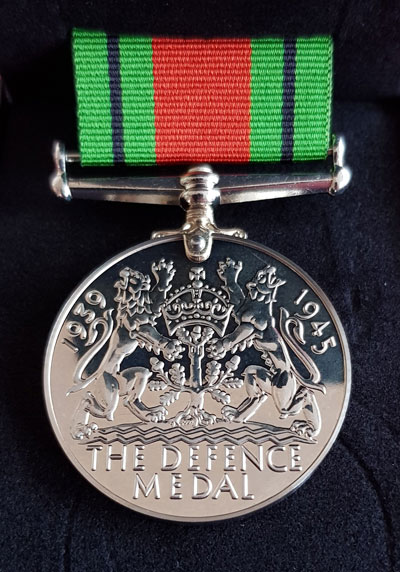JOHN FRANCIS SMITH
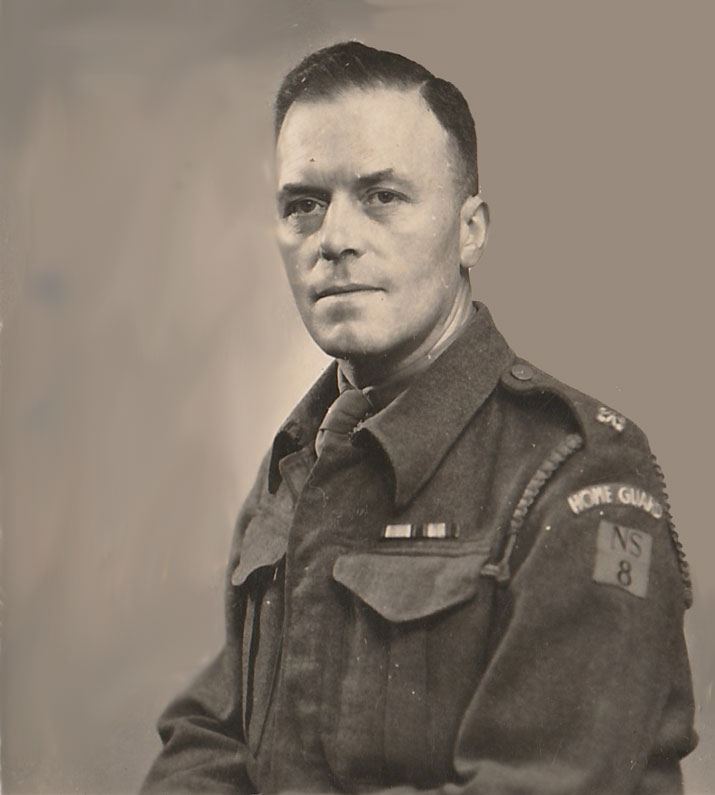 Click
on image to view magnified version Click
on image to view magnified version |
2/Lt. John Francis Smith
(left)
whilst serving with
the
8th North Staffordshire (Burton)
Battalion
and before his promotion to Lieutenant.
After Great War service and subsequent civilian
life in Staffordshire,
John Francis (Jack) Smith
found himself working in
Bristol
prior to World War
II. In
the summer of 1940 he volunteered for
service in the
11th Gloster (City of Bristol)
Battalion, Home Guard,
serving initially as a Corporal and later as a
Sergeant. Details of his life in that Battalion can be
seen on
an associated page in
this website. Later, John Francis returned to Burton,
left the 11th Gloster and joined the
8th
North Staffordshire (Burton) Battalion
where he was commissioned.
This page contains
details of his service with the 8th North Staffs and
also of his earlier Great War service.
|
The Bristol Blitz was a series of heavy bombing raids by the
Nazi German Luftwaffe on the city of
Bristol, England during
World War II. The first raid began around 6 pm on
Sunday 24th of November 1940,
and the city was to endure another five major bombing raids
until April 1941.
As previously mentioned on
the
page describing John Francis's Home Guard service in
Bristol, he was presented with a tankard by his comrades in
the 11th Gloster. This was the occasion.
The inscription on the
tankard shows it was presented to John Francis in 1941. His
occupation in 1939 and 1945 was as a Brewery Representative
for Bass Brewery, Burton-on-Trent.
The brewing industry and the hospitality sector in Bristol
would have been severely affected by the intensity of the
bombing. During the Bristol Blitz, nearly 90,000 buildings
were damaged, and it is likely that John Francis’s work with
the hostelries in Bristol may have “dried up” and forced a
return to Burton-on-Trent,
Staffordshire.
J.H. Bromhead wrote of the time, when
“R” Company Headquarters of 11th
Gloster (City of Bristol) Battalion was based at
White Tree Garage:
“Air Raids on Bristol were also in full swing during our
period there, and the old No.1 Platoon was the first to suffer
badly. Many of the men in this Platoon were involved in one
way or another - their homes or their jobs, and as a result
this Platoon started to lose a number of its original members.
Some transferred to other towns, some to other districts and I
think this is the first occasion on which instead of gaining
new recruits we lost some members.”
(see References 3)
This bears out some of my initial thinking about John
Francis’s transfer to Staffordshire, due to the effect of the
blitz on Bristol and his employment. My research has also led
me to believe he was in No.1 Platoon. Whilst the above was
written in Major Bromhead's memoirs for the period around the
end of 1940, I think it may be a general statement made about
the effect the Blitz bombing was having on the Company’s
numbers over the period of the time known as the Bristol
Blitz. The fact we have a picture showing the then
Sgt. John Francis Smith parading
outside St. Albans Club HQ,
and we know this was not used as an HQ until
May 1941, his move from
Bristol to Burton-on-Trent
was after this date.
The shoulder badge in the above
portrait clearly shows John Francis Smith was serving with the
8th North Staffordshire (Burton)
Battalion as a 2nd Lieutenant. A single epaulette badge
on his left shoulder denotes this rank.
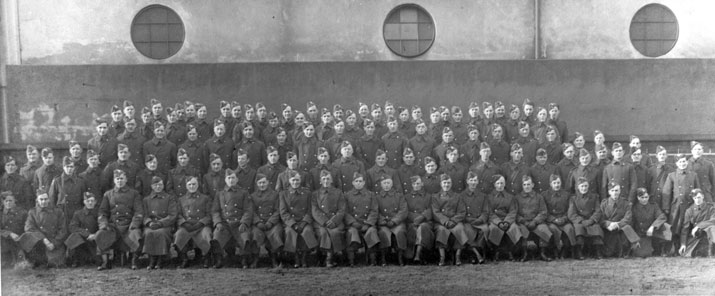
Click on image to view
magnified version
The picture above, found
in my father’s possessions, is of the
North Staffordshire 8th (Burton) Battalion. I counted
106 Home Guard members in the photo. At the time this
photograph was taken, John Francis had been promoted to
Lieutenant. Lt. John Francis Smith is in the front row ninth
from the left. The two Lieutenant pips can be clearly seen on
his left shoulder epaulette in the cropped image below.
(I think this photograph
was taken at the same location as the Officer Stand Down photo
below - P.57 of
original publication.
I have not at this time identified the location.)
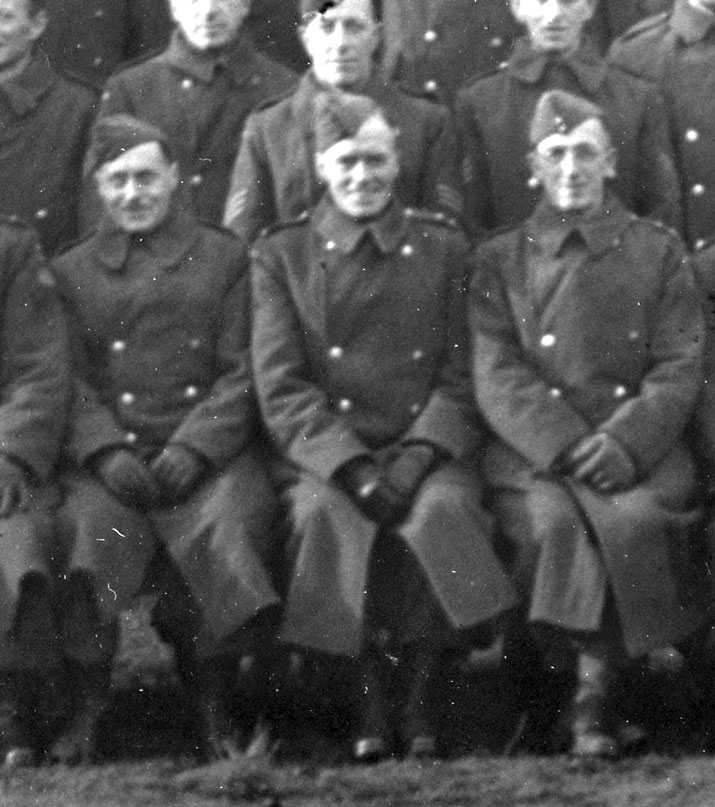
The
following photograph shows Lt. John Francis Smith,
(front row, 3rd from left),
and a volunteer to his left holding trophies. The composition
of the photograph suggests the trophies are for a shooting
competition. There were many competitions held as part of
training. There are 22 members in the photo.
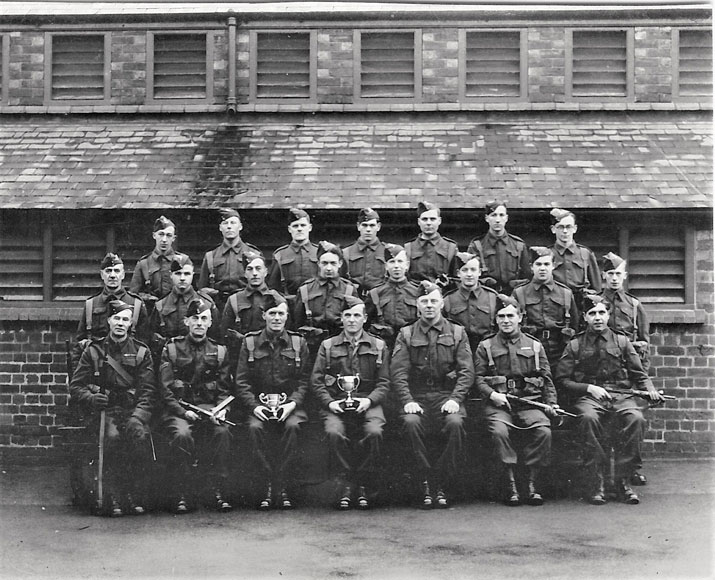
Click on image to view
magnified version
The following newspaper article, found in The British Library
Board’s British Newspaper Archives, describes one such event
(see Reference 10 below).
This could conceivably be the event for which the trophy photo
above was taken. Although the shooting team described
consisted of 24 members it may be that on the day the photo
was captured only 22 members were available to sit - I think
the photo may have been taken on a later day to the actual
event and presentation. Lt. J.F. Smith is not mentioned in the
article, but he may be holding the Sub-District Cup, and the
volunteer to his left may be holding an individual marksman
trophy, so perhaps he is either Pte.
Malliber or Pte. Grieg?
|
Staffordshire
Advertiser Saturday 16th September 1944
HOME GUARD RIFLE COMPETITION
Cup Goes to Burton
The Sub-district Home Guard Rifle Competition was held
on Saturday and Sunday when 24 members from each of
the battalions competed.
There was keen rivalry for
the Sub-district Cup, which was won by the
8th
(Burton-on-Trent) Battalion and the standard of
marksmanship was high.The conditions imposed for
the competition were that the competitors had to march
four miles to the range in full marching order within
an hour. They then had to double 100 yards to the 300
yards range and fire five rounds within a minute.
Another minute was allowed to cover the distance from
the 300 yards to the 200 yards firing point and the
firing of five rounds, and a similar time was allowed
for doubling to the final stage at 100 yards and
firing the remaining five rounds.The possible score for
individual marksman was 60, and the aggregate score
for the Burton-on-Trent team was 968.
Pte. Malliber
and
Pte. Grieg
each returning 49 and
Pte. Cotton
and
Pte. Parker
46.
The
14th (Stafford and Rugeley)
Battalion came
second with an aggregate of 812.
Cpl. Sargeant,
with a score of 51, having the distinction of putting
up the best performance in the competition.
Pte. Barlow,
of the same Battalion scored 46.
Third place was taken by
the 10th (Lichfield and
Tamworth) Battalion,
whose aggregate of 7674 included a 47 by
Lieut. Marsh
and a 46 by
L/Cpl. Smith.
Other individual marksmen
who made good scores were
Cpl. Farr
48,
Sgt. Bennison
48, and
Pte. C Fox
46 (Stone);
Lieut. Tabbiner
50 (Hanley);
L/Cpl. Sal
48 and
2nd Lieut. Moss
46 (Leek);
L/Cpl. Woodhead
and
Pte. Jackson
46 (Cannock);
Pte. Kelly
47 (Newcastle Borough);
and L/Cpl. Parrington
48 and
L/Cpl. Bentley
47 (Cheadle).
The Sub-district Cup was
presented to the Burton team by District Commander,
who congratulated the competitors on their fine
performances. He mentioned that the motorized
divisions in the Army were trained to march 10 miles
in two hours and said he believed that the men whom he
had watched that day would with a little more training
prove themselves equal to such a test.
Among the visitors to the range were the Col.
The Earl of Harrowby (Lord
Lieutenant of Staffordshire), Lt-Col.
Sir G. Percival Heywood Bart, D.S.O., Col.
C. L. Longstaff, C.B.E.,
the Sub-district Commander, Home Guard Advisor, Sector
and Battalion Commanders.
|
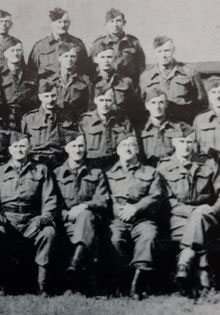 |
The last
picture currently known to have been taken of John Francis
Smith is most probably this one. It is one section of a photo
which, in its entirety, shows Officers of the 8th (Burton) North Staffordshire Home
Guard Stand Down
(See Reference 9
below).
Lt. John Francis Smith is in
the 2nd row, 3rd from right.
In the picture, although it is
grainy, one can see that John Francis appears to be unwell by
the way he is holding himself.
This photo was taken around
December 1944, so less than a year before his death. If
he was unwell at this time then he may not have returned to
work, though I am unable to be sure of this.
The
entire Battalion photograph is shown below, together
with a transcription of
its original caption.
(Please note that a magnified version of
the image is available elsewhere within this section
of the website). |

Click on image to view
magnified version
The original image is fully captioned and these are
the names of all the men:
The Officers of the 8th
Staffordshire (Burton) Battalion Home Guard – Stand Down,
1944
Back
Row – Lt F.J. Crossley, Lt. G.T. Griffiths, 2/Lt.
E. Elliot, Lt. J. Hall, Lt. W.G.R Arblaster, Lt. A.A.
Bull, 2/Lt. A.J.C. Loescher, Lt. K.F. Hewes, Lt. A.S.
Myrtle, Lt. A.E. Stott, 2/Lt. J.E. Porteous, 2/Lt. E.C.
Harrison, 2/Lt. A. Rowland, Lt. J.G. Lester, 2/Lt. W.
Buchanan, 2/Lt. G.R. Roobottom, Lt. J.M. Knight, 2/Lt.
W.S. Johnson, Lt. H. Forrester, Lt. W. Felthouse, Lt. R.F.
Webster, 2/Lt. J. Broom, M.M.
Third
Row – 2/Lt. F. Leadbetter, Lt. R.C. Harrison, 2/Lt.
A.W. Croft, 2/Lt. G.T. Woollett, Lt. T.W. Ford, Lt. P.
Guest, Lt. T.H. Barron, Lt. T.W. West, Lt. H.W. Cohen,
2/Lt. J.C. Salt, G.M., Lt. S.W. Mack, Lt. G. Jones, 2/Lt.
M.L. Howe, Lt. P. Harrison, Lt. H.J. Hallett, 2/Lt. F.J.
Jones, Lt. W.R. Garnham, M.M.
Second Row – Lt. S.J. Turner, Lt. A.R. Evans, Lt.
F.W. Bailey, Lt. L.H. Stoneystreet, Lt. J. Rogers, Lt.
A.E. Irwin, Lt. L.J. Savage, Lt. E, Ironmonger, Lt. R.H.
Scott, Lt. J Atterbury, Capt. H.W. Beaman, Capt. J.
Birkbeck, Lt. C.H. Underhill, Capt. S.V. Ward, Lt. H.
Bray, Lt. C.R. Birt, Lt. C. Gallimore, Lt. T. Tipper, Lt.
G.J. Rees, Lt. J.F. Smith, Lt. R.W. Drewitt, M.S.M., Lt.
A.E. Radford.
Front
Row – Capt. M.C. Hill, Capt. R.M. Cameron, Capt.
I.L. Pass, Capt. G. Haynes, Major J.L. Searle, Major W.J.
Ison, M.S.M., Major H.A. Parson, Major F.R. Durose, Capt.
T. Whitehead (Capt A and Q), Major C.H.P. Goddard, Lt-Col.
S.R. Sharp, M.M., Capt. S. Cartwright, M.M. (Adjt), Major
N.J. Cochran, M.B.E., Major W.P. Riley, M.C., Major G.C.
Keen, Major S. Buxton, Major J.P. Frost, Major E.
Gardiner, Capt. H.A. Norton, M.M., Capt. E.B. Priest,
Capt. A.H. Buckland, Capt. G.F. Kidd.
**********
John Francis died on 12th
September 1945 at Bristol General
Hospital, less than a year after he appeared with all
his comrades in the photograph above. The cause of death, as noted on the death
certificate dated 16th Dec 1945, was Carcinoma of Larynx
(Throat cancer). The death certificate shows that Margaret,
his wife, was present at his death.

John
Francis was cremated at Canford
Crematorium; his ashes were scattered on the grounds
there but the precise location is not known. We always assumed
his throat cancer was caused by smoking and this may certainly
have been a contributory factor. However, it should also be
considered that the gases used during World War 1, which he
would have been exposed to, were carcinogenic in nature, and
exposure to them could lead to developing cancers in later
life, so this could well have also been a contributory factor
in his early death.
I discovered his brother,
Owen Walton Smith, died on the
22nd of March 1945 just a
few months before John Francis. Intrigued, I ordered a copy of
his death certificate - the cause of death was Carcinoma
Bronchus (Lung Cancer). During my research, I discovered Owen
Walton Smith (241107), was in the same regiment (2/6th
North Staffs) as John Francis during The Great War -
though Owen was transferred to the 2/5th and then the 4th
North Staffs. The transfers most probably occurred during the
time when the 2/6th was being reduced to a Training Cadre in
1918: this followed the Spring Offensive by the German Army
when the 2/6th North Staffs Regiment was decimated during the
attacks that began on March 21st,
1918.
(See Reference 11 below)
It is interesting to note that they both died from cancers of
the respiratory system and that they both served with the same
Regiment which experienced heavy gas attacks during World War
1.
Enlisting in October 1916,
Corporal John Francis Smith
served with the 2/6th and
1/6th North Staffordshire Regiments
during World War 1. I have discovered information that
suggests he served with the 2/6th Battalion HQ and saw action
on the battlefields of the Somme, Ypres,
Polygon Wood, and Passchendaele
in 1917 and would have been
present during the taking of the
Riqueval Bridge during the Battle
of St. Quentin Canal at the end of
September 1918, a pivotal
point in the war when the Allies broke through the German
Lines. This victory led to the collapse of the German front
and the end of the war.
(See References 11, 12 below)
Corporal
John Francis Smith was awarded the
British War and Victory Medals for his WW1 service,
below (front and rear
views).
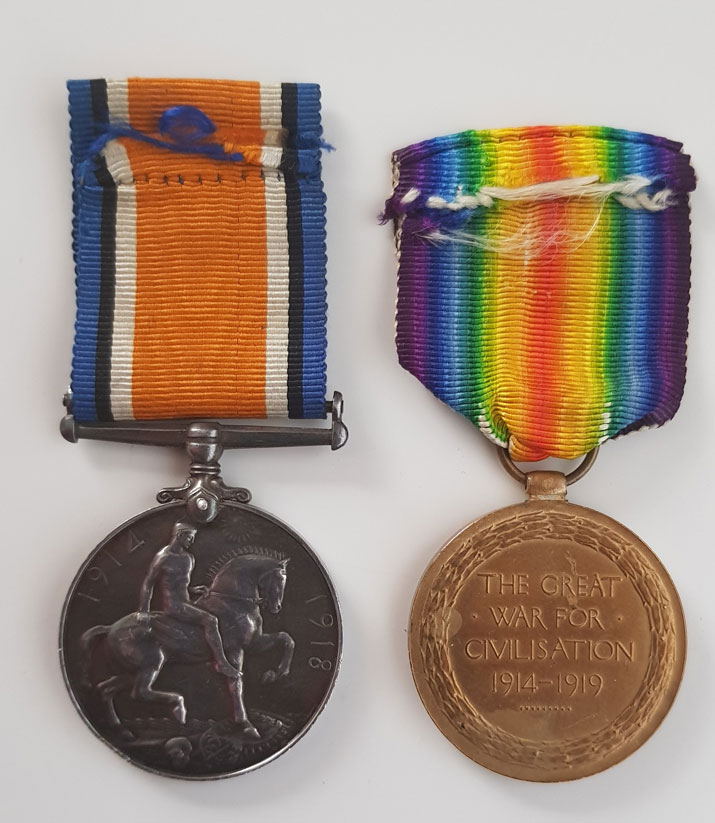 |
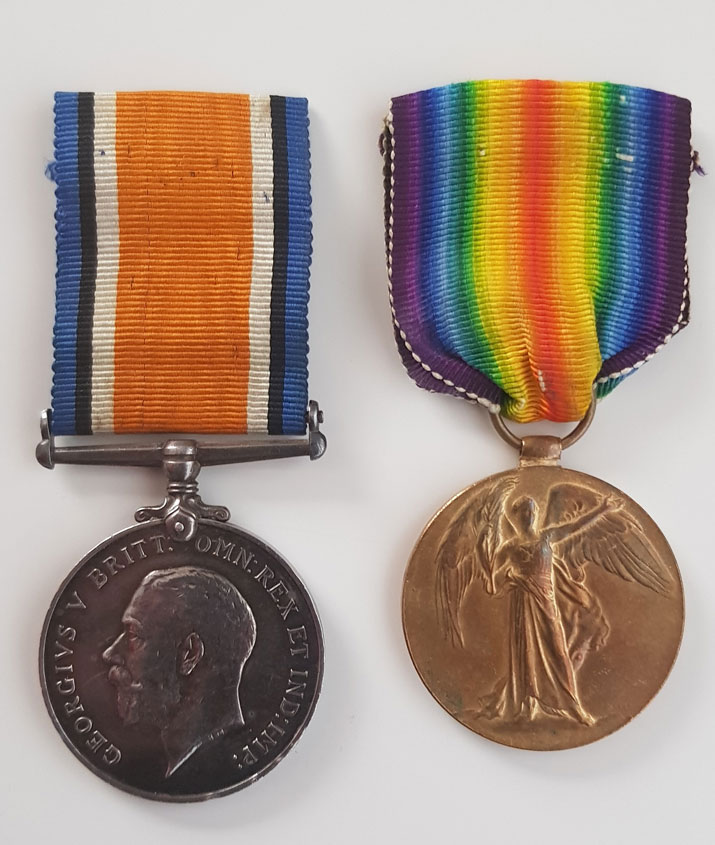 |
NOTES ON DEFENCE MEDAL
Application and Award
|
John Francis’s early
death meant he did not receive a Defence Medal.
I applied posthumously to the British Army
Historic Disclosures Division by way of completing the
required forms
(see Reference 12a
below) and sending a cheque payment. The
initial form, sent in February 2020, was not processed
prior to the first lockdown, this understandably
caused a delay. In or around July 2020, I received a
reply, along with my cheque, stating that no action
could be taken on the application as the payment would
be out of date before they could process it, and they
suggested that I should reapply with a freshly dated
cheque. Fortuitously, I had just sent off a new
application as I was unsure if they had received the
first one - as the cheque had not been cashed. I think
the two letters crossed in the post.
So again,
I waited, and more lockdowns ensued. Over a year
later, in mid-October 2021, I received a reply from
the Army Personnel Centre, along with my 2nd cheque,
thanking me for my enquiry, and advising that after an
extensive search, no file could be found for John
Francis Smith, quoting that to facilitate a search his
service number was required. As you can imagine I was
quite disappointed with this news after such a long
wait. However, I did not give up, and a chance comment
I made against a photo, posted on the “Remember
Britain’s Home Guard” Facebook page, sparked a reply
from a member of the group who explained how, from the
1939 Register, the National Identity Number could be
identified. This proved fortuitous, and so on the 9th
of October 2021, I sent off my 3rd application, to
Army Personnel, with the new information I had found
since the last application, i.e., the National
Identity Number, and the knowledge of his serving with
the 11th Gloucestershire Home Guard.
Then on
the 4th of December 2021, I received a letter from the
Ministry of Defence, stating they were pleased to
advise that the award of the Defence Medal in respect
of my grandfather’s service during the 1939-45 War had
been approved and was awaiting despatch. It was a
delight to receive this notification. On the 17th of
December 2021, we received the delivery of his Defence
Medal.
Of course, I still had not received any service
records, I understood that due to the lockdowns they
had a backlog of applications to work through. So, I
waited patiently, and on 17th of March 2022, I finally
received, from the Army Personnel Centre, the contents
of the Home Guard record for John Francis Smith. The
record consisted of his “Form of Enrolment in the
Local Defence Volunteers”. The form provided welcome
new information and answered many of my questions, but
sadly not all of them - however, I am grateful for the
information that it does provide.
|
|
**********
DEDICATION
To all the ordinary people who made sacrifices during
wartime, your courage, determination, and selflessness
were an inspiration to us all. You put yourselves in
harm’s way to protect our country, our families, and
our future.
We salute you and we thank
you for your service, we will never forget your
sacrifice.
We Will Remember You. |
**********
NOTES
and REFERENCES
9. From "The 8th (Burton)
Battalion of the Staffordshire Home Guard. An Appreciation of
Their Record of Service to Their King and Country".
This important image has been kindly
shared by Austin Oz J. Ruddy who owns a copy of this
booklet. Photographer unknown. Austin Oz J. Ruddy is the
administrator and owner of the Remember
Britain’s Home Guard Facebook page.
A copy of the booklet is available in the R.W. Salt
Library at the Staffordshire Archives. I understand there are
no other mentions of Lt. John Francis Smith within the book.
10.
The British Library Board’s, British Newspaper Archives. The
newspaper in which the article was found is noted in the body
of the text. All articles in this history have been manually
transcribed by the author, Ian Smith.
11. UK, WW1 War Diaries
(France, Belgium and Germany), 1914-1920. National Archives-
2nd 6th Battalion North Staffordshire Regiment - WO95-3021
(transcribed by Ian Smith)
12.
UK, WW1 War Diaries (France, Belgium, and Germany), 1914-1920.
National Archives - 1st 6th Battalion North Staffordshire
Regiment – WO 95-2685 (transcribed by Ian Smith)
12a.
https:/www.gov.uk/apply-medal-or-veterans-badge/apply-for-a-medal Home Guard Service Questionnaire
plus MOD Medal Application form.
|

